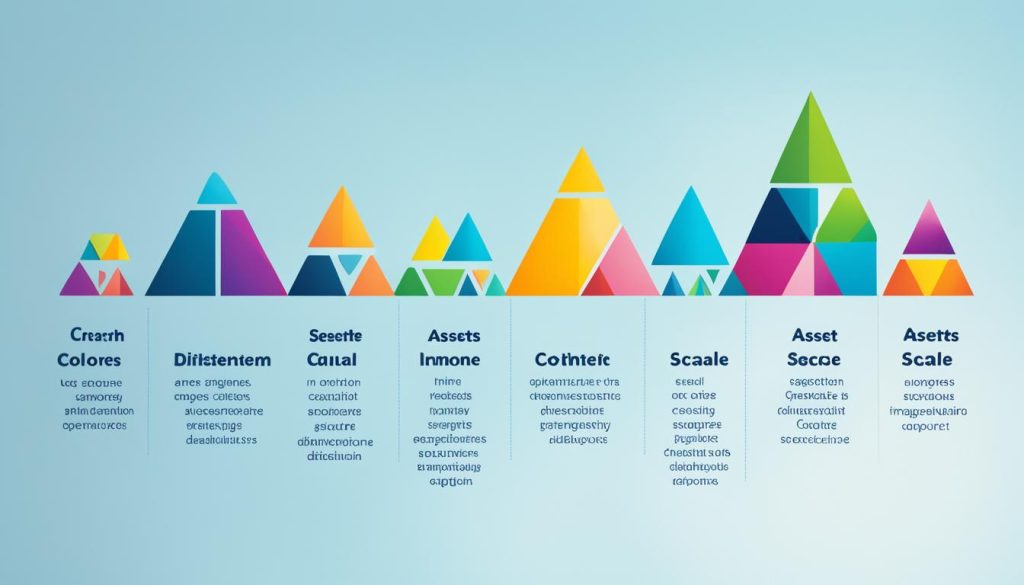Portfolio maximization is all about finding the best way to increase your investment profits while reducing risks. It means looking at different investment options and adapting to market changes. This strategy uses a mix of risky and safe investments. The goal is to make your money grow faster than inflation and average market returns, aiming for significant profit increases. By following modern portfolio theory and behavioral finance, investors can make smart choices on where to put their money.
Key Takeaways
- Portfolio maximization involves a strategic balance of aggressive and conservative assets.
- Leveraging modern portfolio theory and behavioral finance guides optimal investment decisions.
- Effective portfolio maximization aims for growth that outpaces inflation and market averages.
- Investment optimization ensures wealth accumulation and long-term financial sustainability.
- Regular re-balancing is crucial to maintain alignment with financial goals and market conditions.
Understanding Portfolio Maximization
Portfolio maximization is about choosing the best mix of investments to get the highest returns with a certain risk level. It’s key for growing your money over time. Investment theories help guide these choices.
Definition and Importance
At its basic level, portfolio maximization is how you spread your investments across different types to balance risk and reward. It’s crucial for getting the best performance while keeping potential losses low. By picking investments that match how much risk you’re ok with, you can handle ups and downs in the market better.
Historical Background
The idea of portfolio maximization started with Harry Markowitz’s work in the 1950s, called Modern Portfolio Theory (MPT). MPT pushed the idea of spreading out investments to lower risk. It’s had a big impact on financial planning today, meshing well with new technology.
Key Principles of Investment Optimization
Understanding investment optimization is key for any investor wanting to boost their portfolio. By using strong strategies such as diversifying, balancing risks with rewards, and doing regular checks, one can grow their wealth. This also helps in managing risks well.
Diversification Techniques
Diversification is a core strategy in investment optimization. It means spreading your investments across different asset classes, sectors, and places. This helps reduce risks from market upheavals. By not putting all your eggs in one basket, your portfolio can stand strong against economic slumps and potential losses.
Balancing Returns and Risks
Balancing risk and return is crucial, too. Investors always juggle between the desire for high returns and the fear of high risk. To manage risk well, one must keep adjusting their investments as markets and goals change. Keeping this balance is key to growing wealth while avoiding big losses.
Importance of Regular Reviews
Doing regular checks on your investment is vital to keep it on track with market changes and your own goals. These reviews help you move or rebalance your assets to make the most of new chances. By regularly checking your strategies, you can continue to grow your wealth and manage risks effectively.
Effective Asset Allocation Strategies
To build a balanced portfolio, you need to focus on an asset allocation strategy. This strategy involves different ways to spread out your investments. It aims to manage risks and boost performance.
Strategic Asset Allocation
Strategic asset allocation lays the groundwork for a strong investment strategy. It divides assets based on long-term objectives, risk management preferences, and anticipated gains. It creates a stable framework that targets consistent success, even when markets change.
Tactical Asset Allocation
Tactical asset allocation, on the other hand, allows for quick changes in investments. This is to take advantage of current market conditions or to avoid potential risks. It’s about enhancing returns by adjusting the portfolio based on economic signals and short-term market trends.
Dynamic Asset Allocation
Dynamic asset allocation is a proactive strategy. It adjusts the mix of assets as the market changes. This method aims to seize growth opportunities while keeping a tight grip on risk management. It works well in unpredictable markets, finding a balance between safeguarding investments and seeking gains.
| Strategy Type | Approach | Risk Management | Performance Maximization |
|---|---|---|---|
| Strategic | Long-term asset distribution | High | Steady |
| Tactical | Short-term adjustments | Moderate | High |
| Dynamic | Continuous rebalancing | Adaptive | Variable |
Risk Management in Portfolio Maximization
Managing risk is key to growing your investments. Investors must weigh the chance of gains against possible losses. This involves looking closely at market trends, world events, and economic signs. For lasting success, seeing risk management as a core part of planning is crucial.
Identifying Potential Risks
First, investors need to spot risks in their portfolios. They need to look at market changes, economic outlooks, and global issues. By being alert and informed, they can prepare for market ups and downs. This early step lays the groundwork for handling risk.
Risk Mitigation Techniques
After finding potential risks, it’s vital to protect your investments. Investors can limit losses using stop-loss orders or balance risks with derivatives. Keeping a diverse mix of assets also helps lessen the impact of any market shock. With smart risk management, investors not only keep their investments safe but also set the stage for future growth and stability.
FAQ
What is portfolio maximization, and why is it essential for investors?
Portfolio maximization helps investors increase their gains while keeping risks low. It includes looking at different investments and using strategies to grow and protect wealth. It’s key for financial growth and stability, using modern theories.
Can you provide a brief historical background of portfolio maximization?
Portfolio maximization started in the 1950s with Harry Markowitz’s Modern Portfolio Theory (MPT). MPT showed how diversifying investments can lower risk. This idea has shaped how people invest today and is key to planning investments.
What are the key principles of investment optimization?
Investment optimization is based on diversifying, balancing risk and returns, and regular reviews. Diversification reduces market risks. Balancing risks and returns aims for good rewards for the risks taken. Regular reviews keep portfolios suitable for goals and market changes.
What are some effective asset allocation strategies?
Some top asset allocation strategies are strategic, tactical, and dynamic asset allocation. Strategic allocation sets a long-term investment plan. Tactical allocation makes short-term market-based adjustments. Dynamic allocation shifts with market trends to aim for the best performance.
How does diversification benefit an investment portfolio?
Diversification spreads investments across different areas, reducing risks from economic downturns. It creates a more stable portfolio. This approach leads to steadier profits over time.
Why is regular review important in portfolio management?
Regular reviews help keep investments in line with goals, risks, and market changes. Adjustments can improve performance and adapt to market shifts. This is key to keeping investments on track.
What role does risk management play in portfolio maximization?
Risk management identifies and reduces investment risks. Techniques like stop-loss orders and a balanced asset mix prevent big losses. It’s essential for growing and protecting wealth wisely.
What are some common risk mitigation techniques in investment?
Key risk mitigation methods are stop-loss orders, hedging, and a varied asset mix. They protect against big losses. These strategies are vital for keeping investments safe and growing wealth.






